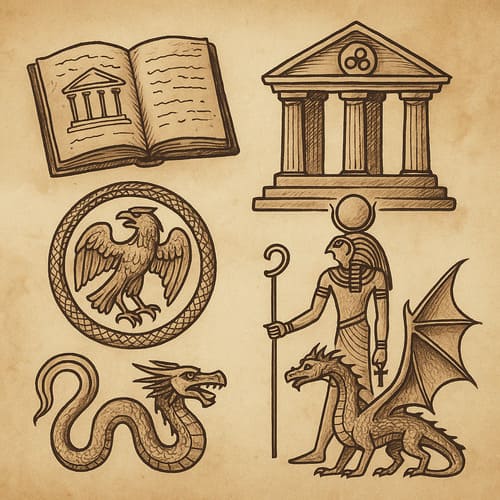What Is a Myth? Definition, Origins, Purpose, and Examples
Since the origins of humanity, myths have been the way cultures have explained the universe, life, and the unknown. In this guide, you will discover what a myth is, how they emerged, what functions they serve, and why they continue to be so important today.
Definition of myth
A myth is a traditional story that explains the origin of the world, gods, human beings, or natural phenomena. These stories are symbolic, sacred, and orally transmitted from generation to generation.
Myths have been essential in all cultures, helping people understand the inexplicable and make sense of the world around them.

Academic perspective:
According to the historian of religions Mircea Eliade, myth is a true narrative that recounts events that occurred at the beginning of time and that serve as a model for human rituals and behaviors.
The anthropologist Claude Lévi-Strauss interpreted myths as universal structures that reveal the symbolic thinking of cultures.
What is the origin of myth as a form of storytelling?
Myths were born in antiquity as a way to explain the inexplicable. In times when science did not exist, peoples resorted to oral stories to make sense of the universe, the cycle of life, death, and their own existence.
- They emerged in the first civilizations: Sumeria, Egypt, Greece, India, China, Mesoamerica...
- They were transmitted orally, from generation to generation.
- They were deeply linked to religious rituals, magic, and social organization.
In this context, myth was not a "fiction," but a sacred reality that explained the world and guided human behavior.
Many of the myths we know today come from ancient texts such as Hesiod's Theogony, the Popol Vuh, the Egyptian Book of the Dead, or the Norse Eddas.

What is a myth used for?
Myths served as a guide to understanding the world and humanity's place in it. They acted as sacred answers to existential questions, helping cultures establish norms, values, and a connection with the divine.
Myths fulfill multiple functions:
- Explain natural and cosmic phenomena.
- Justify the origin of gods, human beings, and society.
- Transmit cultural values and behavioral models.
- Reinforce the collective identity of a community.
- Connect with the sacred through rituals.
Examples of famous myths
Throughout history, each culture has created its own myths to explain the world and its place in it. These stories, loaded with symbolism, speak of creator gods, brave heroes, divine punishments, and natural phenomena that, without scientific understanding, were interpreted as the work of the sacred.
Myths not only transmit beliefs, they also reveal values, fears, and aspirations of the peoples who told them. From Prometheus stealing fire in Greece, to the Popol Vuh narrating the Mayan creation, each myth preserves an essential part of the cultural identity that originated it.
| Myth | Culture | What it explains |
|---|---|---|
| Prometheus and fire | Greek | The origin of fire and divine punishment |
| Osiris and Isis | Egyptian | Death, resurrection, and eternal love |
| Popol Vuh | Mayan | The creation of human beings and the world |
| Izanagi and Izanami | Japanese | The creation of the Japanese archipelago |
| Ragnarök | Norse | The end of the world and the fate of the gods |
Are you interested in the complete classification?
Explore the types of myths here →
Is a myth the same as a legend?
No. Although they share similar traits, they have different functions and structures:
- The myth has a religious or sacred character and explains the origin of the world or its elements.
- The legend is based on historical facts or characters with fantastic elements.
Do you want to understand their differences in more detail?
Discover the differences between myth and legend →
